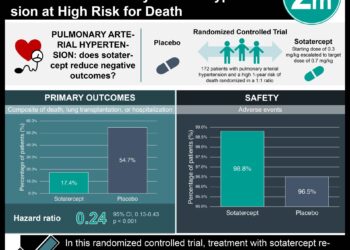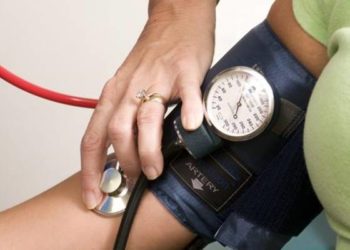The DASH trial: Diet change significantly reduces blood pressure [Classics Series]
Image: PD
1. A “combination” diet rich in fruits and vegetables and low in saturated and total fat reduces blood pressure in comparison to the typical American diet
2. Blood-pressure reductions were observed in the setting of stable weight, unchanged sodium intake, and consumption of no more than two alcoholic drinks per day
Original Date of Publication: April 17, 1997
Study Rundown: At the time of the Dietary Approaches to Stop Hypertension (DASH) trial, national guidelines recommended reduced salt intake, weight control, and reduced alcohol consumption as nutritional means of controlling high blood pressure. Observational studies suggested that increased vegetable consumption can reduce blood pressure as well, but follow-up trials assessing the effect of individual nutrients on blood pressure were inconclusive. The DASH trial sought to assess the effect of dietary patterns, rather than individual nutrients, on blood pressure control.
Results showed that, in comparison to a typical American diet low in fruits and vegetables, a diet rich in fruits and vegetables (the “fruit-and-vegetable” diet) significantly reduced systolic and diastolic blood pressure, while a “combination” diet rich in fruits and vegetables and low in saturated and total fat reduced blood pressure even further. Blood pressure reductions were greater in hypertensive participants than non-hypertensive participants. Notably, the reduction in blood pressure in hypertensive participants was similar in magnitude to reductions achieved through mono-drug therapy.
A strength of this trial was the large proportion of minorities enrolled; >60% of participants were from minority groups for all three experimental diets. This was done to reflect the disproportionate burden of hypertension in minority populations. Moreover, diets in the study were designed so that the salt content was kept at 3 g/day. Participants were also allowed to consume 1-2 alcoholic beverages per day, and weight-loss was not a required goal. These findings suggest that the blood pressure reduction achieved by the DASH diets are meant to complement, rather than supplant, current recommendations to reduce salt and alcohol consumption. Limitations of the trial include the lack of long-term assessment of the DASH diet’s efficacy, as the trial consisted only of an 11-week feeding period. Notably, patients’ ease of adherence to the diet was also not evaluated.
In summary, the DASH trial showed that dietary modification involving increased vegetable and fruit consumption and decreased fat consumption offers an additional approach to lowering blood pressure.
Click to read the study in NEJM
In-Depth [randomized controlled trial]: The DASH trial was a randomized, multi-centered trial that enrolled 459 participants. Eligible participants were at least 22 years of age, did not take any antihypertensive medication, and had an average systolic blood pressure (BP) greater than 160 mmHg and a diastolic BP of 80-95 mmHg. Exclusion criteria included poorly controlled diabetes, hyperlipidemia, a cardiovascular event in the previous 6 months, BMI>35, renal insufficiency, alcoholic beverage intake >14 drinks/week, and unwillingness to stop taking medications or dietary supplements. Approximately 150 participants were randomized to each of the following diets: 1) the control diet (i.e., low in vegetables and fruit with a fat content similar to the typical American diet), 2) the “vegetable-and-fruit” diet (i.e., higher in vegetables and fruit), and 3) the “combination” diet (i.e., higher in vegetables and fruit and lower in fats). For each group, participants’ BPs were screened at baseline first, then all participants were given the control diet for 3 weeks. Afterwards, participants in the “vegetable-and-fruit” diet and the “combination” diet were switched to their respective diet, and all diets were continued for an additional 8 weeks. Diets were designed to include commonly available foods in different forms (fresh, frozen, etc.), and all foods were prepared similarly and using the same brand-name items at each study center.
Results show that the “vegetable-and-fruit” diet reduced systolic BP by 2.8 mmHg (p<0.001) and diastolic by 1.1 mmHg (p=0.07) compared to the control diet. The “combination” diet reduced systolic BP by 5.5 mmHg (p<0.001) and diastolic BP by 3.0 mmHg (p<0.001). For participants with hypertension, the “combination” diet reduced systolic BP by 11.4 mmHg (p<0.001) and diastolic BP by 5.5 mmHg (p<0.001). For participants without hypertension, the “combination” diet reduced systolic BP by 3.5 mmHg (p<0.001) and diastolic BP by 2.1 mmHg (p=0.003).
© 2012-2014 2minutemedicine.com. All rights reserved. No works may be reproduced without written consent from 2minutemedicine.com. Disclaimer: We present factual information directly from peer reviewed medical journals. No post should be construed as medical advice and is not intended as such by the authors or by 2minutemedicine.com. PLEASE SEE A HEALTHCARE PROVIDER IN YOUR AREA IF YOU SEEK MEDICAL ADVICE OF ANY SORT. Content is produced in accordance with fair use copyrights solely and strictly for the purpose of teaching, news and criticism. No benefit, monetary or otherwise, is realized by any participants or the owner of this domain.





